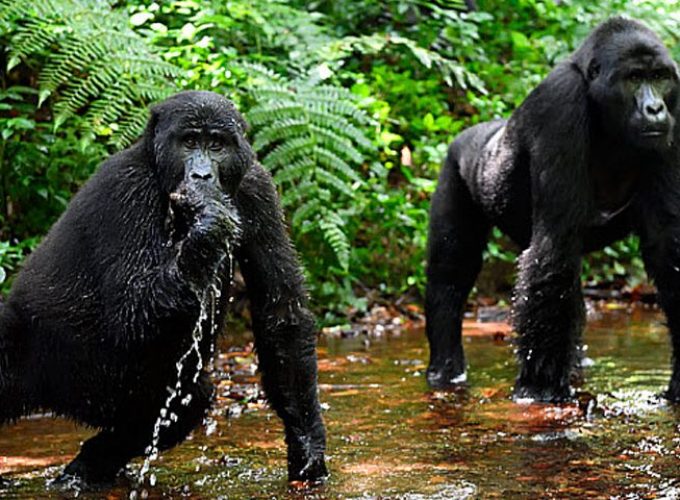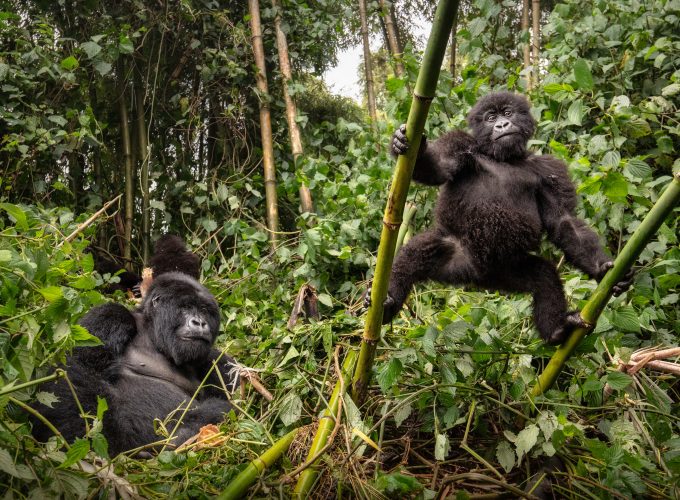Discovery of Gorillas
Discovered only in 1902, Captain Robert von Beringe in his quest to map the boundaries of German East Africa, gorillas were eventually brought to world attention by researcher Diane Fossey who inspired by Dr. Leakey dedicated and gave her life to research on the gorillas and the famous former “poacher dog,” Digit, the mountain gorilla with whom she formed a bond in life and death inspiring the 1988 drama “Gorillas in The Mist.”
The Virunga Mastif
The Greater Virunga Landscape which is also part of the Albertine Rift iis richest in endemic and threatened species including all of the world’s mountain gorillas, grauers gorillas, and chimpanzees.
Containing 8 national parks, 4 forest reserves, and 3 wildlife reserves, this landscape straddles the border of the Democratic Republic of Congo, Rwanda, and Uganda. Virunga, Bwindi Impenetrable Forest, and Rwenzori National Parks are World Heritage sites, while Queen Elizabeth National Park is a UNESCO Biosphere Reserve, and Lake George is a Ramsar site.
The potential to sell the region as one region bloc is immense especially with Democratic Republic of Congo now a full member of the East African Community (EAC)
Mountain gorillas move freely, crossing these geographical borders shared by Uganda and Rwanda, as well as the DR Congo in what is known as the Greater Virunga Landscape. In August 2019, Hirwa family crossed from the northern part of Rwanda known as Kinigi, and to Mgahinga in Uganda.
GORILLA NATIONAL PARKS IN THE VIRUNGA MASTIF
Mgahinga Gorilla National Park is perched in the clouds at an altitude of between 2,227 and 4,127 meters. As its name suggests, it was created to protect the rare mountain gorillas that inhabit its dense forests. It is also an important habitat for the endangered golden monkey
As well as being important for wildlife, the park also has a huge cultural significance in particular for the indigenous Batwa pygmies. This tribe of hunter-gatherers was the forest’s “first people,” and their ancient knowledge of its secrets remains unrivaled.
Bwindi Impenetrable Forest National Park
Located in southwestern Uganda, the Bwindi Impenetrable Forest is said to be Africa’s oldest rainforest. It is world-renowned for its excellent gorilla-sighting opportunities. The rugged landscape features dense jungle, cascading waterfalls, sparkling mountain streams, deep valleys and steep ridges. This untouched forest has been declared a UNESCO World Heritage Site because of its breathtaking natural beauty and unique ecological significance. Aside from the amazing gorilla interactions, there are other drawcards such as a network of forest walks, over 340 species of bird to spot and a variety of butterflies. Don’t miss the opportunity to explore the pristine water falls
Bwindi Impenetrable National Park lies on the edge of the Rift Valley. Its mist-covered hillsides are blanketed by one of Uganda’s oldest and most biologically diverse rainforests, which dates back over 25,000 years, almost 400 species of plants. More famously, this “impenetrable forest” also protects an estimated 400 +mountain gorillas – more than half of the world’s population, 120 mammals, including several primate species such as baboons and chimpanzees, as well as elephants and antelopes. The park boasts 350 species of birds including 23 of the 24 Albertine Rift endemics namely the spectacular, and globally threatened, African Broadbill and Shelly’s Crimsonwing
Mount Mgahinga Gorilla National Park
Mgahinga Gorilla National Park sits high in the clouds, at an altitude of between 2,227m and 4,127m. It is home to the habituated Nyakagezi gorilla group – a fairly nomadic bunch that have been known to cross the border into Rwanda and the Congo. The family includes the lead silverback Bugingo who is around 50 years old and father to most of the group; his silverback sons, Mark and Marfia; and two blackbacks, Rukundo and Ndungutse, who love to pose and play in the trees. The two females, Nshuti and Nyiramwiza, both have babies Furraha and Nkanda respectively. The endangered Golden Monkey is endemic to the Albertine Rift, and Mgahinga Gorilla National Park offers a rare chance to track these striking creatures
Volcanoes National Park in Rwanda
Spanning on a 160 sqkm area in the northern part of Rwanda, Volcanoes national park is part of the great Virunga volcano conservation region spanning to cover Virunga National Park Congo and Mgahinga Gorilla National Park Uganda. It was initially a small area around Karisimbi, Mikeno and Visoke volcanoes which was gazetted to protect the Mountain gorillas which were facing the threat of extinction as a result of poaching.
In 1929, Volcanoes national park was extended into Rwanda and the then Belgian Congo and was named Albert national park managed and run by the Belgian Colonial Authorities. During the early 1960s, the park was divided as Rwanda and Congo gained their independence and by the end of that decade, the park was almost half of its original size.
In 1967, the American primatologist Dian Fossey who had been doing research on mountain Gorillas in the forests of Congo fled from insecurity and established her research base at a place between Visoke and Karisimbi volcanoes that was yet to be known as Karisoke research center. She spearheaded the conservation campaign of the mountain gorillas and mobilized resources to fight against poaching in this area, a fight she put up until her murder in 1985. She was buried at the research center next to the grave of her favorite gorilla called Digit.
The park continued to suffer at the mercies of poachers though conservation efforts were also underway. In the early 1990s, the park became a battlefield for Rwanda’s civil war which paralyzed tourism activities until 1999. In 2005, in a bid to boost conservation and gorilla tours in Volcanoes national park, Rwanda introduced the annual baby naming ceremony for baby gorillas known as ‘Kwita Iziina’ which has seen great results in as far as gorilla population in volcanoes is concerned.
Virunga National Park
Virunga National Park (covering an area of 790,000 ha) comprises an outstanding diversity of habitats, ranging from swamps and steppes to the snowfields of Rwenzori at an altitude of over 5,000 m, and from lava plains to the savannahs on the slopes of volcanoes. Mountain gorillas are found in the park, some 20,000 hippopotamuses live in the rivers and birds from Siberia spend the winter there.
Virunga National Park was created in1925in eastern Democratic Republic of the Congo , making it Africa ‘s oldest national park . Its goal was initially to protect mountain gorillas . Originally it was referred to as Albert Park ; its current name dates from1969. It was later expanded to1929, then in1950, reaching its current size.
The park covers 7,900 km2 from the Virunga mountains in the south to the Rwenzori mountains in the north, it includes a large part of Lake Edward and the Rwindi plains . This diversity of landscapes has enabled the existence of the most significant biodiversity of any protected area in Africa. Several emblematic species find a favorable habitat there, lions ( Panthera leo ), amphibious hippos ( Hippopotamus amphibius ) as well as three taxa of great apes: the mountain gorilla, Grauer’s gorilla ( Gorilla beringei graueri) and the eastern chimpanzee ( Pan troglodytes schweinfurtii ).
In1979, it is consecrated world heritage [ 1 ] , but joins the list of world heritage in danger in1994. It has also been designated a Ramsar site since1996[ 2 ] .
Throughout its turbulent history, Virunga National Park has had to face several armed conflicts and it has long been a fallback area for armed militias. Thus, as of November 2020, more than 200 rangers have paid with their lives for the protection of this exceptional site.



